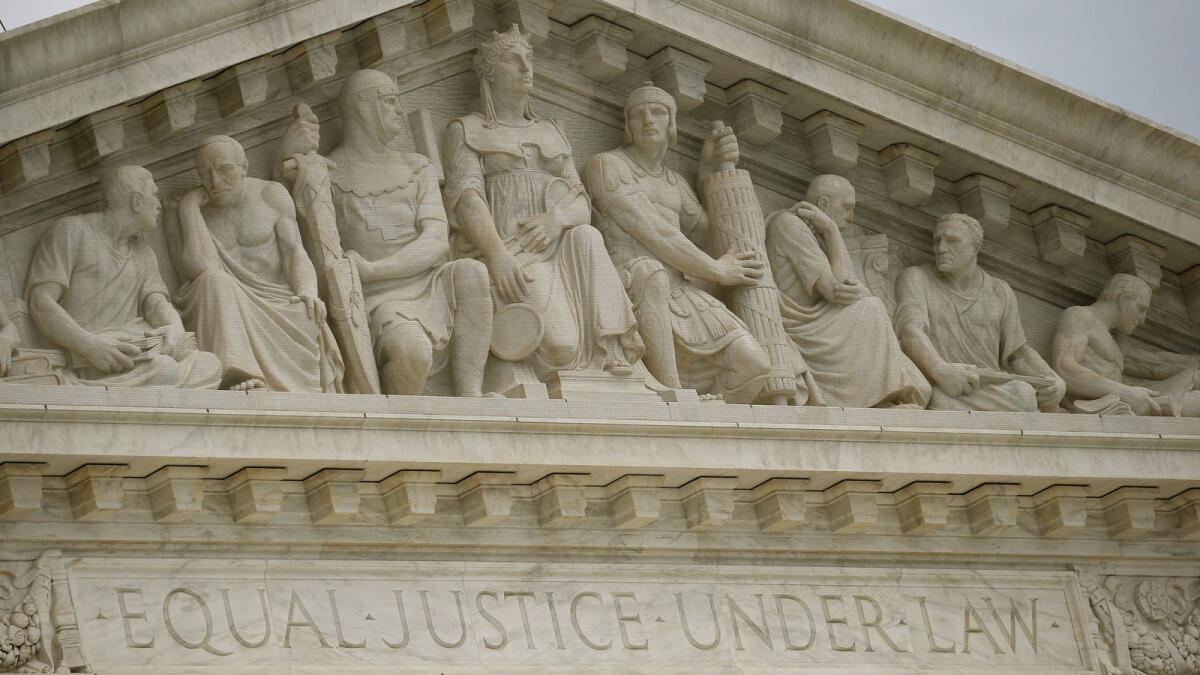Supreme Court is faulted for shielding police officers from excessive-force claims

WASHINGTON â Amid nationwide protests over police killings, the Supreme Court is facing pressure to reconsider the legal immunity that often shields officers from being sued for using excessive force, including brutal arrests and the shooting of innocent people in their homes.
The high court has been sharply criticized from the left and the right for rulings in the last decade that have made it nearly impossible for many victims of police brutality or wrongful shootings to sue the officers for violating their rights. Since police officers are rarely charged with a crime, the court-created doctrine of âqualified immunityâ from civil lawsuits has meant no redress for victims and little accountability for those who abuse their authority, according to the critics.
In recent weeks, justices have been considering several appeals from victims urging the court to reverse course and allow these claims to go before a jury.
Lawyers behind the appeals say the images of a Minneapolis police officer pressing his knee onto the neck of unarmed black man who is handcuffed and gasping for breath should weigh on the justices.
âIt makes for grim coincidence,â said Jay Schweikert, a lawyer for the Cato Institute, which has waged a campaign against police immunity. âThe senseless violence committed by [police officer] Derek Chauvin â and the stunning indifference of the officers standing by as George Floyd begged for his lifeâ is the product of our culture of near-zero accountability for law enforcement. I expect the events of the past week will increase their sense of urgency, because the justices are culpable for this doctrine that they have expounded.â
He noted that the issue has been taken up by protesters who carried signs that say, âAbolish Qualified Immunity.â
He and others are encouraged because legal scholars have strongly disputed the doctrine of qualified immunity, and justices on the right and left have voiced doubts. Justices Clarence Thomas and Neil M. Gorsuch have questioned the doctrine because it was invented by judges, while Justices Sonia Sotomayor and Ruth Bader Ginsburg warned about its practical impact.
The courtâs stance has âsent an alarming signal to law enforcement officers and the public. It tells officers that they can shoot first and think later,â Sotomayor said, dissenting in Kisela vs. Hughes in 2018. Without bothering to hear arguments in the case, the justices overturned a lower court and tossed out an excessive-force claim brought by a Tucson woman who was shot four times while standing in her front yard by an officer who had just arrived on the scene.
The Tucson officer had no cause to make an arrest, and he faced no danger. Nonetheless, the justices ruled the shooting victim could not sue the officer because there was no specific past ruling that âclearly establishedâ it was unreasonable for a police officer to shoot someone in this particular circumstance.
He and two other officers had responded to a call reporting that a woman had a large kitchen knife in her hand. The officer said he feared she might attack another woman standing nearby, who turned out to be her roommate. So he decided to shoot through her chain-link fence.
Three years earlier, the justices tossed out an excessive-force lawsuit brought by a mentally ill San Francisco woman who was shot in her private room in a group home. A social worker had reported Teresa Sheehan was not taking her medication, but when two officers tried to force their way into her room, she reacted angrily and told them to get out. A few minutes later, they pushed the door open again, and when Sheehan grabbed a bread knife, they shot her five times.
The Supreme Court said they were entitled to immunity in San Francisco vs. Sheehan, again because there was not a clearly established past ruling that prohibited shooting a person under these circumstances.
This legal shield gives officers âbreathing room to make reasonable but mistaken judgments,â Justice Samuel A. Alito Jr. said. It âprotects all but the plainly incompetent or those who knowingly violate the law. ⌠The Constitution is not blind to the fact that police officers are often forced to make split-second judgments,â he added. (Sheehan later won a settlement from the city based on a separate claim arising from the Americans with Disabilities Act.)
Legal scholars say the justices have radically rewritten one of the nationâs first and most important civil rights laws, one that gave all Americans the protection of the federal courts.
Shortly after the Civil War, the Reconstruction Congress passed the Ku Klux Klan Act of 1871 to extend federal protection to African Americans and Union sympathizers in the South. They could not depend on local officials, the state or its courts to protect their rights. One provision of the new law said that âany personâ who acts âunder color of any lawâ and who deprives someone of âany rights, privileges or immunities secured by the Constitution shall be liable to the party injuredâ in a suit in federal court. It includes no immunity for police or local officials.
In cases of police arrests, the constitutional right at issue would be the 4th Amendmentâs ban on âunreasonable searches and seizures.â Courts have long said that using excessive force to seize and hold a suspect violates the 4th Amendment. An officer who wrongly kills someone could also be accused of violating the 14th Amendment, which says the state shall not âdeprive any person of life ... without due process law.â
The 1871 law remains on the books and is known to lawyers as Section 1983 of the U.S. Code. But since the 1980s, the high court has curbed this right-to-sue law. Instead, it has ruled government officials, including police officers, may not be sued unless it is âbeyond debateâ that their actions violated a âclearly establishedâ precedent.
In practice, however, judges are divided on what that means. Some courts have said the law is not clearly established unless a plaintiff can point to a past case with identical circumstances, even though most cases differ in some ways.
The Supreme Court is being asked to reconsider this rule in a series of pending appeals.
The case of Baxter vs. Bracy began when Alexander Baxter, an African American man and a suspected burglar, was chased by the police into the basement of a house in Nashville. An officer called out he would release a police dog unless Baxter gave up. The man sat with his hands raised over his head. But seconds after coming upon him, one officer unleashed a dog, which badly bit Baxter under his raised arms, sending him to a hospital.
Baxter sued for an unreasonable and excessive use of force. Officers Brad Bracey and Spencer Harris said the suit should be dismissed based on qualified immunity, but a federal judge refused. The police appealed to the U.S. 6th Circuit Court of Appeals, and their case came before three President Trump appointees: Judges John Nalbandian, Amul Thapar and John K. Bush. They ruled 3-0 to dismiss Baxterâs claim.
âThe officersâ conduct, whether constitutional, did not violate any clearly established right,â they said. âBaxter does not point us to any case law suggesting that raising his hands, on its own, is enough to put [police officer] Harris on notice that a canine apprehension was unlawful in these circumstances.â
The American Civil Liberties Union urged the Supreme Court to hear Baxterâs appeal. The decision throwing out his suit âis an archetypal example of the problems with current qualified immunity doctrine,â said Scott Michelman, an ACLU lawyer. âAny reasonable officers in the shoes of Harris and Bracey would have known that unleashing a police dog against Baxter after he surrendered by raising his hands in the air was unconstitutionally excessive force.â
Amy Corbitt, a Georgia woman, sued after her 10-year-old son was shot by Officer Michael Vickers after he came onto her property to arrest an unrelated suspect. For reasons that remain unclear, the officer fired shots twice at a family dog who posed no threat. Her son was lying on the ground, but the second shot hit him in the back of his knee. A federal judge refused to dismiss her suit, but the U.S. 11th Circuit Court of Appeals in Atlanta did so by a 2-1 vote.
âWe hold that Vickers is entitled to qualified immunity because ... there was no clearly established law making it apparent to any reasonable officer in Vickersâ shoes that his actions in firing at the dog and accidentally shooting [the child] would violate the 4th Amendment,â said Judges R. Lanier Anderson, a President Carter appointee, and Britt Grant, a Trump appointee.
In dissent, Judge Charles R. Wilson, a President Clinton appointee, said that because no competent officer would fire his weapon in the direction of a nonthreatening pet while that pet was surrounded by children, qualified immunity should not protect Officer Vickers.
The Supreme Court will convene by phone on Thursday to consider pending appeals, including Corbitt vs. Vickers , Baxter vs. Bracey and seven others that call on the justices to reconsider the scope of qualified immunity. Also pending are several gun rights cases. The court could announce action on these appeals on Monday.
More to Read
Get the L.A. Times Politics newsletter
Deeply reported insights into legislation, politics and policy from Sacramento, Washington and beyond. In your inbox three times per week.
You may occasionally receive promotional content from the Los Angeles Times.











